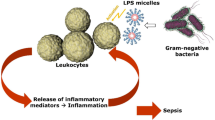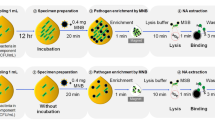Abstract
We present an internationally validated protocol for the evaluation of pyrogenic contaminations using human whole blood. In the in vitro pyrogen test (IPT) the sample is incubated with fresh or cryopreserved human whole blood, and the proinflammatory cytokine interleukin-1β (IL-1β) is detected by enzyme-linked immunosorbent assay (ELISA). In addition to detecting pyrogenic contaminations in aqueous samples, e.g., parenteral drugs; adaptations allow the assessment of lipidic, toxic or immunomodulatory substances; detection of low-grade contaminations in large-volume parenterals, e.g., dialysis water and fluids; pyrogenicity assessment of solid materials, e.g., medical devices; and evaluation of airborne pyrogenic burden. In contrast to the rabbit pyrogen test and the limulus amoebocyte lysate (LAL) test, it requires no components of animal origin. In comparison with the LAL, it also detects nonlipopolysaccharide pyrogens. In comparison with other monocyte activation tests it requires no cell preparation steps or cell culture facilities. The procedure takes 21–35 h to complete.
This is a preview of subscription content, access via your institution
Access options
Subscribe to this journal
Receive 12 print issues and online access
$259.00 per year
only $21.58 per issue
Buy this article
- Purchase on Springer Link
- Instant access to full article PDF
Prices may be subject to local taxes which are calculated during checkout






Similar content being viewed by others
References
Morath, S., Geyer, A. & Hartung, T. Structure-function relationship of cytokine induction by lipoteichoic acid from Staphylococcus aureus . J. Exp. Med. 193, 393–397 (2001).
Tsuchida, K. et al. Detection of peptidoglycan and endotoxin in dialysate, using silkworm larvae plasma and limulus amebocyte lysate methods. Nephron 75, 438–443 (1997).
Watson, D.W. Host-parasite factors in group A streptococcal infections. Pyrogenic and other effects of immunologic distinct exotoxins related to scarlet fever toxins. J. Exp. Med. 111, 255–284 (1960).
Bodel, P.T. & Atkins, E. Studies in staphylococcal fever. V. Staphlococcal filtrate pyrogen. Yale J. Biol. Med. 38, 282–298 (1965).
Brunson, K.W. & Watson, D.W. Pyrogenic specificity of streptococcal exotoxins, staphylococcal enterotoxin, and gram-negative endotoxin. Infect. Immun. 10, 347–351 (1974).
Atkins, E. & Huang, W.C. Studies on the pathogenesis of fever with influenzal viruses. I. The appearance of an endogenous pyrogen in the blood following intravenous injection of virus. J. Exp. Med. 107, 383–401 (1958).
Braude, A.I., Mc, C.J. & Douglas, H. Fever from pathogenic fungi. J. Clin. Invest. 39, 1266–1276 (1960).
Kobayashi, G.S. & Friedman, L. Characterization of the pyrogenicity of Candida albicans, Saccharomyces cerevisiae, and Cryptococcus neoformans . J. Bacteriol. 88, 660–666 (1964).
Beeson, P.B. Temperature-elevating effect of a substance obtained from polymorphonuclear leucocytes. J. Clin. Invest. 27, 524 (1948).
Dinarello, C.A. et al. Tumor necrosis factor (cachectin) is an endogenous pyrogen and induces production of interleukin 1. J. Exp. Med. 163, 1433–1450 (1986).
Dinarello, C.A. et al. Interleukin-6 as an endogenous pyrogen: induction of prostaglandin E2 in brain but not in peripheral blood mononuclear cells. Brain Res. 562, 199–206 (1991).
Dinarello, C.A., Marnoy, S.O. & Rosenwasser, L.J. Role of arachidonate metabolism in the immunoregulatory function of human leukocytic pyrogen/lymphocyte-activating factor/interleukin 1. J. Immunol. 130, 890–895 (1983).
Vellucci, S.V. & Parrott, R.F. Expression of mRNAs for vasopressin, oxytocin and corticotrophin releasing hormone in the hypothalamus, and of cyclooxygenases-1 and -2 in the cerebral vasculature, of endotoxin-challenged pigs. Neuropeptides 32, 439–446 (1998).
Rotondo, D., Abul, H.T., Milton, A.S. & Davidson, J. Pyrogenic immunomodulators increase the level of prostaglandin E2 in the blood simultaneously with the onset of fever. Eur. J. Pharmacol. 154, 145–152 (1988).
Li, S. et al. The febrile response to lipopolysaccharide is blocked in cyclooxygenase-2(-/-), but not in cyclooxygenase-1(-/-) mice. Brain Res. 825, 86–94 (1999).
Li, S., Ballou, L.R., Morham, S.G. & Blatteis, C.M. Cyclooxygenase-2 mediates the febrile response of mice to interleukin-1beta. Brain Res. 910, 163–173 (2001).
Li, S., Goorha, S., Ballou, L.R. & Blatteis, C.M. Intracerebroventricular interleukin-6, macrophage inflammatory protein-1 beta and IL-18: pyrogenic and PGE(2)-mediated? Brain Res. 992, 76–84 (2003).
Hartung, T. & Wendel, A. Detection of pyrogens using human whole blood. Altex 12, 70–75 (1995).
Wiegandt, M. Dissertation. Der Human Vollblut-Pyrogentest – Optimierung, Validierung und Vergleich mit den Arzneibuchmethoden. Heidelberg (2002).
Hoffmann, S. et al. International validation of novel pyrogen tests based on human monocytoid cells. J. Immunol. Methods 298, 161–173 (2005).
Schindler, S. et al. International validation of pyrogen tests based on cryopreserved human primary blood cells. J. Immunol. Methods 316, 42–51 (2006).
Wendel, A. & Hartung, T. Test for determining pyrogenic effect of a material (DPC Biermann GmbH (Bad Nauheim, DE) Wendel, Albrecht (Tubingen, DE), Hartung, Thomas (Konstanz, DE), US Patent 5891728, 1999).
Wendel, A. & Hartung, T. Use of frozen blood in a biological test method (DPC Biermann GmbH (Bad Nauheim, DE) Wendel, Albrecht (Tubingen, DE), Hartung, Thomas (Konstanz, DE), European Patent Ep0851231, 1997).
Hartung, T. Method for assaying flowing media for microbial toxins (Hartung, Thomas (Konstanz, DE) European Patent EP1377835, 2002).
Schindler, S. et al. Cryopreservation of human whole blood for pyrogenicity testing. J. Immunol. Methods 294, 89–100 (2004).
Mazzotti, F. et al. In vitro pyrogen test–a new test method for solid medical devices. J. Biomed. Mater Res. A 80, 276–282 (2007).
Hasiwa, M., Kullmann, K., von Aulock, S., Klein, C. & Hartung, T. An in vitro pyrogen safety test for immune-stimulating components on surfaces. Biomaterials 28, 1367–1375 (2007).
Kindinger, I. et al. A new method to measure air-borne pyrogens based on human whole blood cytokine response. J. Immunol. Methods 298, 143–153 (2005).
Schindler, S. et al. Pyrogen testing of lipidic parenterals with a novel in vitro test–application of the IPT based on cryopreserved human whole blood. Pharmeur. Sci. Notes 2006, 1–7 (2006).
Daneshian, M., Wendel, A., Hartung, T. & von Aulock, S. High sensitivity pyrogen testing in water and dialysis solutions. J. Immunol. Methods 336, 64–70 (2008).
Daneshian, M., Guenther, A., Wendel, A., Hartung, T. & von Aulock, S. In vitro pyrogen test for toxic or immunomodulatory drugs. J. Immunol. Methods 313, 169–175 (2006).
Welch, H., Calvery, H.O., McClosky, W.T. & Price, W.T. Method of preparation and test for bacterial pyrogen. J. Am. Pharm. Assoc. 3, 65–69 (1943).
McClosky, W.T., Price, W.T., van Winkle, W.J., Welch, H. & Calvery, H.O. Results of the first USP collaborative study of pyrogens. J. Am. Pharm. Assoc. 32, 69–73 (1943).
Grant, R. Emotional hypothermia in rabbits. Am. J. Physiol. 160, 285–290 (1950).
Hartung, T. et al. Novel pyrogen tests based on the human fever reaction. The report and recommendations of ECVAM Workshop 43. European Centre for the Validation of Alternative Methods. European Centre for the Validation of Alternative Methods. Altern. Lab. Anim. 29, 99–123 (2001).
Fennrich, S. et al. Detection of endotoxins and other pyrogens using human whole blood. Dev. Biol. Stand. 101, 131–139 (1999).
Dehus, O., Hartung, T. & Hermann, C. Endotoxin evaluation of eleven lipopolysaccharides by whole blood assay does not always correlate with limulus amebocyte lysate assay. J. Endotoxin Res. 12, 171–180 (2006).
Hartung, T. Statement on the validity of the in-vitro pyrogen test (European Centre for the Validation of Alternative Methods, Ispra, 2006).
Pott, G.B., Chan, E.D., Dinarello, C.A. & Shapiro, L. Alpha-1-antitrypsin is an endogenous inhibitor of proinflammatory cytokine production in whole blood. J. Leukoc. Biol. 85, 886–895 (2009).
Poole, E.J., Dawson, P. & Gaines Das, R.E. Second International standard for endotoxin: calibration in an international collaborative study. J. Endotoxin Res. 4, 221–231 (1997).
Dixon, W.J. Processing data for outliers. Biometrica 9, 74–89 (1953).
Grubbs, F.E. Sample criteria for testing outlying observations. Ann. Math. Stat. 21, 27–58 (1950).
Hoffmann, S., Luderitz-Puchel, U., Montag, T. & Hartung, T. Optimisation of pyrogen testing in parenterals according to different pharmacopoeias by probabilistic modelling. J. Endotoxin Res. 11, 25–31 (2005).
Nakayama, G.R., Caton, M.C., Nova, M.P. & Parandoosh, Z. Assessment of the Alamar Blue assay for cellular growth and viability in vitro . J. Immunol. Meth. 204, 205–208 (1997).
Acknowledgements
The authors acknowledge the contributions of countless scientists, technicians, students, authorities and funding institutions to the development and validation of these protocols.
Author information
Authors and Affiliations
Contributions
All authors contributed to the development of the method and the writing of the manuscript.
Corresponding author
Rights and permissions
About this article
Cite this article
Daneshian, M., von Aulock, S. & Hartung, T. Assessment of pyrogenic contaminations with validated human whole-blood assay. Nat Protoc 4, 1709–1721 (2009). https://doi.org/10.1038/nprot.2009.159
Published:
Issue Date:
DOI: https://doi.org/10.1038/nprot.2009.159
This article is cited by
-
Analyzing bacterial extracellular vesicles in human body fluids by orthogonal biophysical separation and biochemical characterization
Nature Protocols (2020)
-
Use of TEOM monitors for continuous long-term sampling of ambient particles for analysis of constituents and biological effects
Air Quality, Atmosphere & Health (2019)
-
Pyrogen detection methods: Comparison of bovine whole blood assay (bWBA) and monocyte activation test (MAT)
BMC Pharmacology and Toxicology (2014)
Comments
By submitting a comment you agree to abide by our Terms and Community Guidelines. If you find something abusive or that does not comply with our terms or guidelines please flag it as inappropriate.



